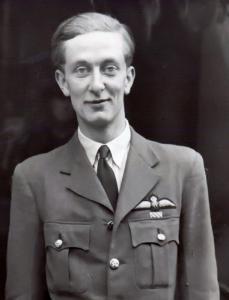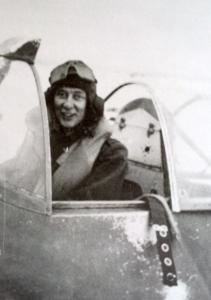
|

|
| Squadron Leader Robert Sinckler WOODWARD (74698) DFC | |
|
263 Squadron Royal Air Force Date of birth: 31st March 1919 Date of death: 7th December 1942 Killed in action aged 23 Commemorated on the Runnymede Memorial Panel 65 |

|
| Robert Sinckler Woodward was born at Simla in India on the 31st of March 1919 the only son of Major Charles Palgrave Woodward, East Kent Regiment, and of Dorothy Margaret (nee Porter) Woodward, of “Fairfield”, Goring-on-Thames. He was educated at Hoylake Preparatory School, West Kirby and at Lancing College where he was in Seconds House from September 1932 to July 1937. He was a member of the Cricket XI in 1936 and 1937, the Hockey XI in 1936 and 1937 and was Team Secretary in 1937. He was in the tennis team and was their Captain in 1937. He was also a member of the Fives Team in 1937 and the Squash Team from 1935 to 1937 and was their Captain in 1935. He won the Public Schools Squash Championship in 1937 and well as becoming British Under 19 Junior Open Squash Champion the same year. He was a Sergeant in the Officer Training Corps and achieved Certificate A in 1937. He was appointed as a House Captain in 1936 and as a Prefect in 1937. He was admitted to Corpus Christi College Oxford in 1938 where he read history. He was a member of the College Squash Team the same year. He also became Secretary of the Oxford University Squash Club and won "Blue" in 1938 and 1939. While at Oxford he joined the University Air Squadron and in June 1939 he became a member of the Royal Air Force Volunteer Reserve as Airman Pilot 754304 under training. He was called up on the outbreak of war with the rank of Sergeant and was commissioned as a Pilot Officer on the 3rd of October 1939 and was posted to 236 Squadron. On the 25th of September 1940 he was posted to A Flight, 600 Squadron flying the Bristol Blenheim and was teamed up with Sergeant Alfred John Lipscombe as his radar operator. He was promoted to to Flying Officer on the 3rd of October 1940. On night of the 19th of November 1940 they were flying Blenheim K7126, with Sergeant Frederick George Hindrup RNZAF as air gunner, and were landing at Catterick when they overran the runway causing the undercarriage to collapse. Although the aircraft was damaged beyond repair, the two airmen were unhurt. On the night of the 3rd/4th of May 1941, near Shepton Mallet, they attacked and shot down Junkers 88 8161 of KuFlGr 806 piloted by Oberfeldwebel Fritz Schafer. The enemy aircraft crashed at 1.15am at Moons Hill Farm, Stoke St Michael in Somerset. The crew baled out, becoming prisoners of war. At 1.39am on the night of the 7th/8th of May 1941, near Bristol, they attacked and shot down Heinkel 111 2862 of II/KG27 piloted by Oberfeldwebel Walter Range who was killed along with his crew, Unteroffizier K. Dillinger and Untefeldwebel A. Habsreiter. The following combat report on the action was filed on his return: - "When near Bristol F/O Woodward was vectored on to a bandit on G.L. Carpet flying at 13,000 feet. On flashing weapon a blip was obtained at maximum range. Quarry was chased for 35/40 miles and on climbing to 14,500 feet a visual was ultimately obtained. Aircraft was identified as hostile but owing to position of moon a good sighting base was difficult to obtain. After manoeuvring for position one long burst put enemy aircraft port engine out of action, causing bandit to dive to left. Violent but erratic return fire was experienced and sight was lost. F/O Woodward dived left and operator picked up blip on A.I. and corrected course. Enemy aircraft port engine appeared on fire and pilot fired another burst from dead astern and slightly below. Flames then appeared from port side and enemy aircraft crashed on Tennyson Down, Freshwater, Isle of Wight where it burnt out. This enemy aircraft is claimed as destroyed." Woodward's aircraft had fired 30 cannon and 240 machine gun bullets during the engagement and been hit by the return fire, sustaining minor damage which had pierced the self sealing fuel tanks. During a flight the night of the 9th/10th of May 1941, while flying Beaufighter M1F T4641 far out to sea, they were attacked in error by Flying Officer R.A. Chisholm of 604 Squadron and their aircraft was set on fire. They were unable to regain their base and were forced to bale out; both men landed safely. For this action he was awarded the Distinguished Flying Cross, which was announced by the Air Ministry on the 29th of August 1941. The citation reads:- “This officer has shown great perseverance and keenness during night-flying operations and has destroyed three enemy aircraft. One night in May, 1941, his aircraft was set on fire when a considerable distance out to sea. Nevertheless, Flying Officer Woodward succeeded in flying the burning aircraft back over this country and did not abandon it until he had first ensured that his observer had left the aircraft safely. In pressing home his attacks against the enemy, Flying Officer Woodward has displayed great skill and determination.” At 3.20am on the morning of the 9th of July 1941, near Abergavenny, they attacked a Heinkel 111 which was seen diving through the clouds in flames. On his return Robert Woodward made the following combat report: - "I took off from Colerne 0130 hours. Landed Colerne 0330 hours, working with G.C.I. Huntspill. After a series of vectors ending with 0403 at 12,000 ft I was informed north bound bandit about 5 miles ahead and told to Buster, as I was overtaking too slowly. Contact was obtained at maximum range and lost almost immediately after Operator had told me to throttle back to 120 m.p.h. After further vectors ending with 040 contact was regained. Bandit was then at 11,500 ft so I dived to 10,500 feet keeping the Bandit in contact dead ahead. Our speed then about 160 m.p.h. A visual of a machine exhausts were obtained about 1,000 ft above and ahead. Having identified aircraft as Hostile I closed in climbing slowly to 300 feet and fired a three second burst (cannon and machine guns). (No return fire was experienced). There was a blinding flash and explosion and bits were seen to fly back. I gave another short burst before the enemy aircraft dived sharply to port with flames and smoke coming from its starboard side. The enemy aircraft was last seen by the Operator diving vertically through cloud and in flames. On the strength of further evidence to hand from G.C.I. Huntspill, O/C, and A.A. Posts, I now claim this E/A as destroyed." He had expended thirty rounds from his cannon and two hundred rounds of machine gun ammunition during the engagement. Although he was credited with a confirmed victory subsequent investigations that the Germans lost no bombers in that area that night. One enemy bomber, a Heinkel III-3 of Kg 100, flown by Oberleutnant Hans-Georg Bautcher was badly damaged in the area and was set on fire. However, the pilot managed to extinguish the flames. His gunner was killed during the attack and his radio operator was mortally wounded but he managed to fly his stricken aircraft on one engine and with damaged controls to crash land at an airstrip near Cherbourg. On the 20th of September 1941 their aircraft went into a spin and he ordered Lipscombe to bail out and also took to his parachute. He survived with a broken leg but sadly Lipscombe was killed. He was promoted to Flight Lieutenant on the 3rd of October 1941. When he had recovered he was posted, in March 1942, as Commanding Officer of 263 Squadron operating Westland Whirlwind fighter bombers in the West of England, commanding them until his death. On the 26th of September 1942 he led three other aircraft in a bombing display at West Lulworth. On the 7th of December 1942 he took off from RAF Fairwood Common for an anti shipping strike to Jersey. He led his planes to attack German trawlers off St Brelade’s Bay and after dropping his bombs his aircraft, Whirlwind P7105, was seen to crash-land in the sea. This was witnessed by local fishermen who were unable to assist because of the heavy fighting and he was not seen again. On the 18th of April 1942 he was married to Virginia Cade (nee Stair), of Hassocks, Sussex and they had a daughter, Roberta, born after his death on the 12th of April 1943. Following his death she married Christopher Lawrence Sainty on the 3rd of September 1949. |
|
 | |
| Seconds House |
Back